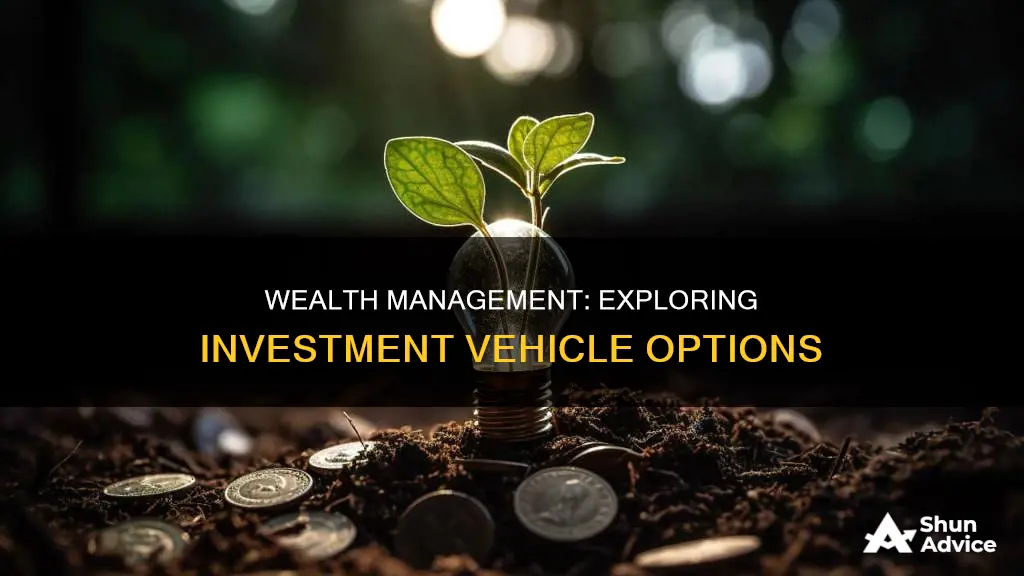
Investment vehicles are financial products used by investors to generate profits and grow their wealth. They can be categorised into two types: direct and indirect investments. Direct investments are specific asset holdings such as stocks, bonds, or rental real estate, where the investor has complete control over which assets to purchase. Indirect investments, on the other hand, are managed by professional portfolio managers who select the investments on behalf of the investor for a fee.
There are numerous types of investment vehicles, each with its own level of risk and potential returns. Some common examples include stocks, bonds, mutual funds, exchange-traded funds (ETFs), real estate, and certificates of deposit (CDs).
Understanding the different investment vehicles and their characteristics is crucial for investors to make informed decisions, manage risk, and build a portfolio aligned with their financial goals and risk tolerance.
| Characteristics | Values |
|---|---|
| Risk | Low: CDs, bonds, cash equivalents |
| High: stocks, options, futures, private investment vehicles | |
| Returns | Positive returns |
| Investment Type | Direct, indirect, pooled, public, private |
| Control | Direct investments: the investor has complete control over which assets to purchase |
| Indirect investments: professional portfolio managers select the investments | |
| Management | Pooled investment vehicles are created and led by sponsors who hire a portfolio management team |
| Liquidity | High liquidity: large pool of willing buyers and sellers, higher trading volumes, up-to-date prices |
| Low liquidity: fewer buyers and sellers, lower trading volumes, stale prices | |
| Cost | Direct investments: lowest cost, no sponsor involved |
| Indirect private investment vehicles: highest costs, complex underlying investments, high asset management fees | |
| Public, indirect investment vehicles: lowest costs, less day-to-day research, less trading in underlying holdings, more tax-efficient | |
| Structure | Direct, indirect, public, private, liquidity terms, costs, leverage |
| Pricing | Set by trades on an exchange (secondary market) or by the sponsor based on the value of the underlying holdings |
What You'll Learn

Stocks
When deciding whether to invest in stocks, it is important to consider the expected return, risk, liquidity, and cost of the investment. Stocks can be volatile, meaning their performance can deviate from the expected return, and they can suffer greater losses than investments with lower volatility. Stocks are also typically more liquid, meaning they can be sold more quickly and easily than other investments.
The cost of investing in stocks includes commissions to enter and exit the investment, as well as taxes on income and capital gains.
Building a Diverse Investment Portfolio: Strategies for Success
You may want to see also

Bonds
There are several types of bonds, including zero-coupon bonds, convertible bonds, callable bonds, and puttable bonds. Zero-coupon bonds are issued at a discount and generate a return once the bondholder is paid the full face value at maturity. Convertible bonds are debt instruments that allow bondholders to convert their debt into stock. Callable bonds can be "called back" by the company before maturity, and puttable bonds allow bondholders to sell the bond back to the company before maturity.
Adjusting Your Child's Future: Editing 529 Investment Portfolio
You may want to see also

Mutual funds
Diversification
Professional Management
Low Investment Requirements
Other Considerations
While mutual funds offer several advantages, there are also some drawbacks to consider. Mutual funds charge annual fees, expense ratios, or commissions, which can reduce overall returns. Additionally, mutual funds may hold a significant portion of their portfolios in cash to satisfy daily share redemptions, which can result in a "cash drag" that earns no return. It's important for investors to carefully consider the fees and potential drawbacks of mutual funds before investing.
In summary, mutual funds are a popular investment vehicle that offers investors access to a diversified, professionally managed portfolio with relatively low investment requirements. However, it's important to carefully research and understand the fees and potential drawbacks associated with mutual funds before investing.
Diversifying Your Investment Portfolio: Strategies for Success
You may want to see also

Exchange-traded funds (ETFs)
ETFs are a popular investment vehicle as they offer investors a diverse mix of asset classes, including domestic and international stocks, bonds, and commodities. They are also considered more tax-efficient than other investment vehicles, such as actively managed mutual funds, as they generate lower levels of capital gain distributions. Additionally, ETFs typically have lower operating expense ratios (OERs) than other investment options, making them an affordable investment choice.
There are several types of ETFs, including index ETFs, fixed-income ETFs, sector and industry ETFs, commodity ETFs, style ETFs, foreign market ETFs, inverse ETFs, leveraged ETFs, and actively managed ETFs. Each type of ETF offers investors different benefits and strategies to achieve their financial goals.
ETFs are also advantageous due to their ease of trading. They can be traded through online brokers and traditional broker-dealers, as well as in retirement accounts. Many platforms offer commission-free trading for ETFs, making them accessible to a wide range of investors.
However, it is important to note that ETFs do have some drawbacks, such as trading costs, illiquidity, and tracking errors. As with any investment, it is crucial to carefully consider all factors before investing in ETFs.
Investing in a Portfolio: Pros and Cons
You may want to see also

Real estate
There are several ways to invest in real estate, each with its own pros and cons. Here are some of the most common methods:
Rental Properties
Rental properties are a good choice for individuals with DIY skills and the patience to manage tenants. This option provides a regular income stream from rent collection and potential appreciation over time. Rental properties can also be leveraged to acquire more properties, creating multiple income streams. However, managing tenants can be tedious and unpredictable vacancies can reduce income.
REIGs are ideal for those who want to own rental real estate without the hassle of hands-on management. They are similar to small mutual funds, where a company pools money from multiple investors to buy or build rental properties. A single investor can own one or multiple units, while the company handles maintenance, advertising, and tenant screening. In exchange, the company takes a percentage of the monthly rent. REIGs provide income and appreciation potential with a more hands-off approach.
REITs are ideal for investors seeking portfolio exposure to real estate without making a traditional property purchase. They are created when a corporation uses investors' money to buy and operate income-producing properties. REITs are traded on major exchanges like stocks, and by law, they must pay out 90% of their taxable profits as dividends to shareholders. This makes them attractive for investors seeking regular income, and they also offer the potential for appreciation. REITs provide access to non-residential investments such as malls or office buildings, which are typically out of reach for individual investors.
Online Real Estate Platforms
Online real estate investing platforms, also known as real estate crowdfunding, allow investors to join others in funding relatively large commercial or residential projects. This option provides an opportunity to diversify into real estate with a smaller stake. However, these investments tend to be illiquid with lock-up periods, and management fees can reduce profits.
RELPs are similar to REIGs but are formed to buy and hold a portfolio of properties or a single property for a finite number of years. An experienced property manager or real estate firm serves as the general partner, while outside investors provide financing in exchange for a share of ownership. RELPs may provide periodic distributions, but the main payoff comes when the properties are sold, hopefully at a substantial profit.
Savings Investment Strategies: Where to Invest Your Money Wisely
You may want to see also
Frequently asked questions
There are many different investment vehicles, each with its own level of risk and potential returns. Here are some examples:
- Stocks and shares: Shares are units of stock that give owners a proportional stake in a company, including voting power and the possibility of dividends.
- Bonds: A bond is a loan to a company or government municipality, generally considered a safer investment.
- Mutual funds: These are portfolios of stocks, bonds, or other securities selected by professional managers and purchased with pooled capital from multiple investors.
- Exchange-Traded Funds (ETFs): ETFs are similar to mutual funds but can be bought and sold on a stock exchange. They typically have lower expense ratios than mutual funds.
- Real estate: This includes primary homes, rental properties, and commercial properties. Real estate can provide a stable source of passive income and long-term wealth accumulation.
Different investment vehicles offer varying levels of risk and return potential. Low-risk investments include certificates of deposit (CDs) and bonds, while stocks, options, and futures carry greater risk. Diversifying your portfolio across different investment vehicles can help to reduce risk and maximise potential returns.
The best investment vehicle for you will depend on your financial goals, risk tolerance, market knowledge, and financial situation. It's important to research and understand the risks and potential returns of different investment vehicles before making any decisions. Consulting a financial advisor can also help you make informed choices that align with your goals.







